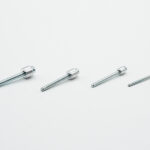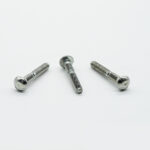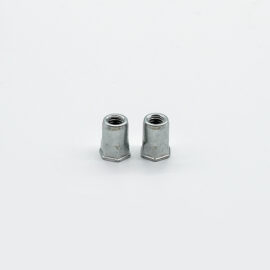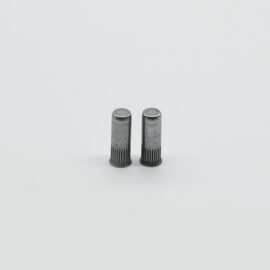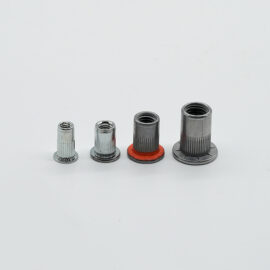BSL® pull rivet nuts provide effective support for internal threads on automotive sheet metal.
BSL® pull rivet nuts provide an ideal solution for rapid riveting and internal thread support on prefabricated holes in automotive sheet metal. This series of fasteners includes a variety of structural types and different connection characteristics, and is widely used in various parts of automobiles with sheet metal as the substrate. Compared with welding methods, they can significantly reduce installation time and maintenance costs, are environmentally friendly and pollution-free, and do not cause overheating damage to the surrounding materials of the sheet metal substrate.
About pull rivet nuts
The structural design of BSL® pull rivet nuts includes anti-rotation structural design and sealing and waterproof structural design that adapt to different sheet metal hole types.
Usage scenarios
1) Flat head type, countersunk head type
The head shape is divided into two types: flat head and countersunk head. The flat head type is a general type, suitable for occasions where there is no requirement for the plane after installation; the countersunk head type is suitable for occasions where the plane after installation is required to be flat.
2) Through hole type, blind hole type (waterproof sealing)
The threaded hole design is divided into two types: through hole and blind hole. Among them, the blind hole nut can play a sealing and waterproof role in the threaded connection part, and is used in connection occasions that require sealing.
In order to further increase the waterproof performance around the connection hole after riveting, the root of the cap edge of the blind hole type product can be glued to improve the overall waterproof performance of the connection
size
| Product Code | D | L | d1 | dk | k | s | S0 | h1 | h |
| Through Hole | Through Hole | ||||||||
| Through hole type | Nominal | refer to | refer to | refer to | refer to | Max | +0.1 | refer to | refer to |
| B1021-LT-050110 | M5 | 11 | 5.9 | 10 | 1 | 6.98 | 7 | 8.4 | 0.5~1.0 |
| B1021-LT-050120 | 12 | 1.0~2.0 | |||||||
| B1021-LT-050130 | 13 | 2.0~3.0 | |||||||
| B1021-LT-050140 | 14 | 3.0~4.0 | |||||||
| B1021-LT-060135 | M6 | 13.5 | 8 | 13 | 1.5 | 8.98 | 9 | 9.5 | 0.5~1.5 |
| B1021-LT-060150 | 15 | 1.5~3.0 | |||||||
| B1021-LT-060165 | 16.5 | 3.0~4.5 | |||||||
| B1021-LT-060180 | 18 | 4.5~6.0 | |||||||
| B1021-LT-080150 | M8 | 15 | 10 | 16 | 1.5 | 10.98 | 11 | 10.8 | 0.5~1.5 |
| B1021-LT-080165 | 16.5 | 1.5~3.0 | |||||||
| B1021-LT-080180 | 18 | 3.0~4.5 | |||||||
| B1021-LT-080195 | 19.5 | 4.5~6.0 | |||||||
| B1021-LT-100180 | M10 | 18 | 11.5 | 19 | 2 | 12.98 | 13 | 13 | 0.5~1.5 |
| B1021-LT-100195 | 19.5 | 1.5~3.0 | |||||||
| B1021-LT-100210 | 21 | 3.0~4.5 | |||||||
| B1021-LT-100225 | 22.5 | 4.5~6.0 |
Performance Table
| Thread specification D | Thread load protection (N) | Head binding force (N) | Shear force (N) | Breaking torque(N.M) | Rotation torque(N.M) |
| Min | Min | Min | Min | Min | |
| M5 | 11500 | 4348 | 2600 | 8.5 | 2 |
| M6 | 16500 | 6149 | 3800 | 15 | 4.5 |
| M8 | 25000 | 9034 | 5400 | 26 | 4.5 |
| M10 | 32000 | 11926 | 6900 | 50 | 11 |
Surface treatment
Since the rivet nut achieves its connection function by clamping the plate through plastic deformation caused by local extrusion of the product, the processing method is usually cold extrusion molding, so the selected material must have good plasticity and meet certain connection strength requirements.
Installation Method
According to the required diameter specification of the connecting bolt and the thread connection strength (thread load required for the nut), determine the product material category and thread specification diameter;
According to the thickness of the sheet metal/plate connection and the exposed installation space, determine the corresponding product length specification according to the recommended riveting range and product type and thread specification of the GB/T17880 series product standard;
According to the special requirements of the installation (whether there is a requirement for flush sheet metal surface, whether there is a high anti-rotation requirement, whether it is sealed and waterproof), select the cap type, rod type, etc.;
Select the surface treatment method according to the product protection requirement level.
Select the corresponding product specification code from the recommended specification table.
(If necessary, please consult with the Bosch product engineer to confirm whether the selection is appropriate.)













